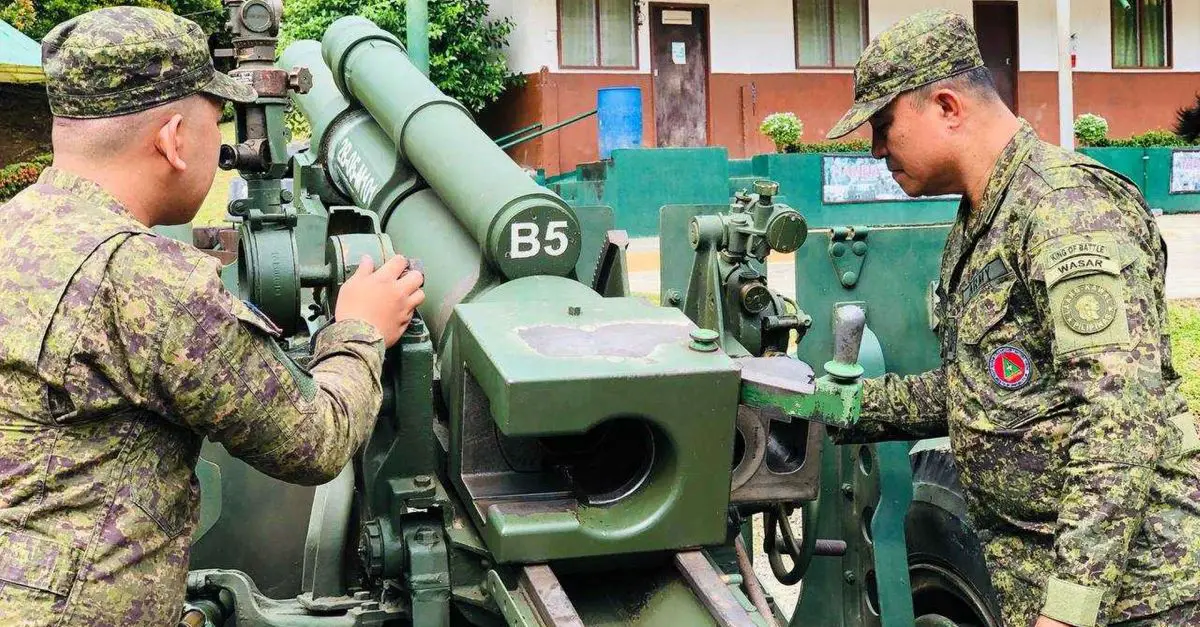Breaking News
Philippine artillery soldiers still training with American WWII-era M101 105mm towed howitzer.
As reported by Manila Standard on September 11, 2024, the 1st Davao del Norte Ready Reserve Field Artillery Battery conducted its monthly formation and mustering on September 8, 2024, at the headquarters of the 2nd Field Artillery Battalion, Army Artillery Regiment, Philippine Army, in the Davao Region. The activity included training on the M101 105mm howitzer, which was the standard U.S. light field howitzer during World War II, focusing on familiarization with its parts, understanding the roles within the gunnery team, and performing gun drills.
Follow Army Recognition on Google News at this link

In the Philippines, the M101 105mm howitzer has been deployed against insurgent groups and was used in direct fire against Islamic militants during the Battle of Marawi in 2017. (Picture source: 2FABAARPA)
The training aimed to enhance the reservists' ability to operate the 105mm howitzer, a key artillery piece used by the Philippine Army. It provided practical experience in handling the equipment and ensured that each team member was proficient in their specific role. The exercise also involved gun drills to improve coordination and response times among team members.
The familiarization training is part of ongoing efforts to maintain the readiness of the reserve forces in Davao del Norte, ensuring they are capable of responding to potential threats as needed. This training serves as a foundation for future exercises and aims to enhance the overall competency of the reservists.
As of 2024, the Philippine Army possesses 204 M101, M102, and Model 56 pack 105mm towed howitzers. These artillery pieces are considered a significant component of the country's defense capabilities. Training activities, such as those conducted by the 1st Davao del Norte Ready Reserve Field Artillery Battery, align with the broader objective of maintaining the operational effectiveness of these resources and ensuring their availability for potential defense needs.

The M101 105mm howitzer, originally designated as the Howitzer M2A2 on Carriage M2A2, is a light artillery piece that fires 105mm high-explosive semi-fixed ammunition and has a maximum range of 11,270 meters. (Picture source: US DoD)
The M101 105mm howitzer, originally designated as the Howitzer M2A2 on Carriage M2A2, is a light artillery piece developed by the United States. It became the standard U.S. light field howitzer during World War II and was used extensively in both the European and Pacific theaters, as well as in the Korean War. Production of the M101 began in 1941 and continued until 1953, with over 10,200 units manufactured. It fires 105mm high-explosive semi-fixed ammunition and has a maximum range of 11,270 meters. Initially designed for towing by horses, the howitzer was later adapted for vehicle towing.
The development of the M101 began after World War I, with the U.S. Army Ordnance Department studying captured 105mm howitzers. Various design modifications were made over the years, leading to the standardization of the M2A1 variant by 1940. A modified M2A2 variant was standardized in 1953, incorporating a stronger breech ring and changes to the barrel's rifling to extend its service life. In 1960, the U.S. military revised its artillery designation system, renaming the M2A1 and M2A2 variants to M101 and M101A1. The M101A1 continued to be used during the Vietnam War and remained in service with other countries after being retired from the U.S. military.
The M101A1 is no longer in active service with the U.S. military but is still used by various countries, including the Philippines. In the Philippines, it has been deployed against insurgent groups and was used in direct fire against Islamic militants during the Battle of Marawi in 2017.


























